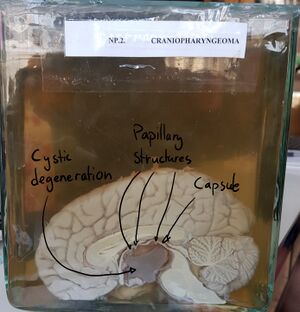41. Craniopharyngeoma: Difference between revisions
(Created page with "'''Organ''': Brain '''Description''': There is a cystic tumor which is encapsulated. The tumor is filled with a greyish liquid material, which is a remnant of cystic degeneration. There are small papillary structures on the inside of the tumor. '''Diagnosis''': Craniopharyngeoma '''Risk factors''': * Nothing special. '''Theory''': This tumor originates from the Rathke pouch, which normally develops into the pituitary and thyroid glands. Craniopharyngeomas commonly...") |
No edit summary |
||
| Line 15: | Line 15: | ||
This tumor originates from the Rathke pouch, which normally develops into the pituitary and thyroid glands. Craniopharyngeomas commonly occur between the corpus callosum and brainstem, in the ''suprasellar'' region. Here they may compress the pituitary and/or optic nerve, causing hypopituitarism and/or visual defects, respectively. | This tumor originates from the Rathke pouch, which normally develops into the pituitary and thyroid glands. Craniopharyngeomas commonly occur between the corpus callosum and brainstem, in the ''suprasellar'' region. Here they may compress the pituitary and/or optic nerve, causing hypopituitarism and/or visual defects, respectively. | ||
[[File:Craniopharyngeoma prep.jpg|center|thumb|Craniopharyngeoma prep]] | [[File:Craniopharyngeoma prep.jpg|center|thumb|Craniopharyngeoma prep]] | ||
[[Category:Pathology 2 - Macropreparations]] | |||
Latest revision as of 16:48, 22 May 2022
Organ: Brain
Description:
There is a cystic tumor which is encapsulated. The tumor is filled with a greyish liquid material, which is a remnant of cystic degeneration. There are small papillary structures on the inside of the tumor.
Diagnosis: Craniopharyngeoma
Risk factors:
- Nothing special.
Theory:
This tumor originates from the Rathke pouch, which normally develops into the pituitary and thyroid glands. Craniopharyngeomas commonly occur between the corpus callosum and brainstem, in the suprasellar region. Here they may compress the pituitary and/or optic nerve, causing hypopituitarism and/or visual defects, respectively.

